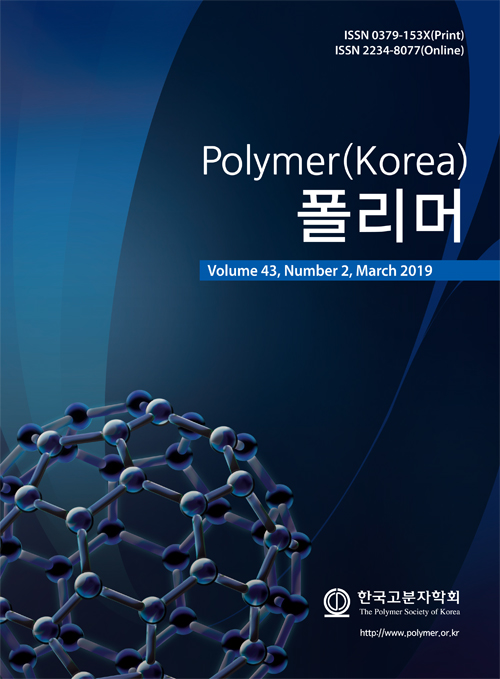Using 3-aminopropyl triethoxysilane (APTES) as the reactive compatibilizer of polyurethane and silica, waterborne polyurethane/silica nanocomposites were synthesized via sol-gel process. The effects of the amount of hybrids formed by the reaction of polyurethane prepolymer and APTES on the morphology, tensile property, water resistance, surface property, thermal stability and dynamic mechanical behaviour were investigated. The formation of urea between NCO in polyurethane prepolymer and NH2 in APTES was confirmed by FTIR. As increasing the amount of hybrids, silica particles in the composites appeared to be more uniform and reduced in size. Tensile strength, surface hardness, water resistance increased with increasing the amount of hybrids in the composites. Thermal stability and dynamic mechanical behaviour were also affected by the amount of hybrids in the composites.
졸-젤 공정을 통하여 수분산 폴리우레탄/실리카 나노복합체를 제조하였다. 3-aminopropyl triethoxysilane(APTES)을 반응성 상용화제로 사용하였으며, 이의 함량이 나노복합체의 모폴로지, 인장물성, 내수성, 표면 특성 및 열안정성, 동적·기계적 거동 등에 미치는 영향을 조사하였으며 상용화제의 아민기와 우레탄 prepolymer의 이소시아 네이트기와의 반응에 의해 우레아 구조를 갖는 하이브리드가 형성됨을 FTIR을 통해 확인하였다. 상용화제의 함량이 증가할수록 복합체 내의 실리카 분산상은 미세하고 균일해졌으며 복합체의 투명도는 향상되었다. 또한 상용화제 함량의 증가에 따라 복합체는 인장강도, 표면경도 및 내수성 등이 향상되었으며 비교적 큰 표면에너지를 가졌다. 열안정성 및 tanδ 등의 동적·기계적 특성도 상용화제 함량의 영향을 받는 거동을 보였다.
Keywords: waterborne polyurethane, silica, sol-gel process, reactive compatibilizer, 3-aminopropyl triethoxysilane
- Polymer(Korea) 폴리머
- Frequency : Bimonthly(odd)
ISSN 0379-153X(Print)
ISSN 2234-8077(Online)
Abbr. Polym. Korea - 2023 Impact Factor : 0.4
- Indexed in SCIE
 This Article
This Article
-
2019; 43(2): 235-242
Published online Mar 25, 2019
- 10.7317/pk.2019.43.2.235
- Received on Oct 16, 2018
- Revised on Nov 19, 2018
- Accepted on Nov 27, 2018
 Correspondence to
Correspondence to
- Su Kyung Kim
-
Department of Polymer Engineering, Chonnam National University, Gwangju 61186, Korea
- E-mail: skkppsl@chonnam.ac.kr










 Copyright(c) The Polymer Society of Korea. All right reserved.
Copyright(c) The Polymer Society of Korea. All right reserved.